
Thailand life
A Free life style
Tropical fruits in Thailand
Thailand is popularly known as the “the land of smiles”, “the land of yellow robes” and probably another popularity of Thailand is a land of tropical fruits as the county is blessed with a myriad of delicious tropical and temperate fruits which only vary depending on the season.
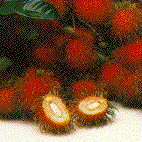 Rambutan
(Ngaw)
Rambutan
(Ngaw)
An attractive fruit with a bright red skin covered in green tipped hairs, the
rambutan is a delicious, white fleshy fruit. Thai rambutans are particularly
noted for their sweetness.
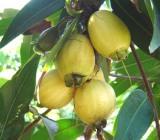 Rose Apple (Chomphu)
Rose Apple (Chomphu)
The rose apple is bell shaped, with a glossy, edible skin that can be either
green or pink. It is crisp and slightly acidy in taste.
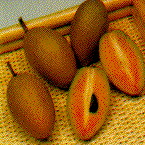 Sapodilla (La-Mut)
Sapodilla (La-Mut)
Similar in shape to a small mango, the sapodilla is eaten when ripe by removing
the peel and slicing the reddish brown flesh.
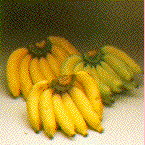 Banana (Kluay)
Banana (Kluay)
About twenty different varieties grow in Thailand. It is a versatile fruit, used
in various forms. They can be eaten raw when young and green as a vegetable with
a spicy sauce; others, still un-ripe are sliced, dried in the sun and fried for
a snack. They are also grilled and soaked with syrup; boiled in coconut milk
with salt and sugar; boiled in syrup; smoked in their skins or turned into
golden fritters.
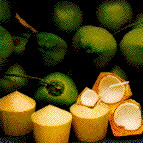 Coconut (Ma-Phraw)
Coconut (Ma-Phraw)
Available throughout the year, coconuts appear in almost every Thai dish. The
milk is a prominent ingredient is soups and curries, where the sliced or grated
flesh also features. It is even more frequently used in desserts either as a
custard, or as a candy, as crispy strips cooked in brown syrup and countless
other confections.
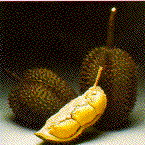 Durian (Thurian)
Durian (Thurian)
The legendary durian is renowned for its distinctive aroma. The durian is
regarded as the king of fruits, a rare and expensive delicacy. Of the large
fruit it is the creamy golden flesh within the spiny exterior which is eaten.
Thai durians are noted for their subtle flavour and smooth texture.
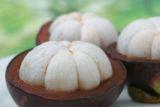 Mangoesstin
(Mangkood)
Mangoesstin
(Mangkood)
The apple-shaped mangosteen has a deep purple leathery skin. Its
interior has 5-7 segments of juicy white flesh, some containing a large seed.
The segments are enclosed in dark pink pith, which should be removes before
eating. The flesh is sweetly refreshing, highly fragrant and slightly tart. Eat
it fresh or add to fruit salad
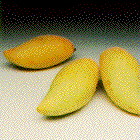 Mango (Ma-Muang)
Mango (Ma-Muang)
Thailand grows more than a dozen varieties of mango, the variety determining the
way in which it is eaten. Some, particularly the light yellow and slightly
darker types, are traditionally served at the peak of ripeness, accompanied by
sticky rice and coconut milk. Others are more often eaten as a condiment or in
salads when the skin is still dark green and the flesh white. Some mangos can be
pickled.
 Guava (Farang)
Guava (Farang)
One of the most popular snacks, guava can be eaten when ripe or still green,
often dipped in salt and sugar. There are two varieties, the usual white flesh
type or one with bright red flesh when peeled.
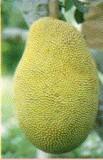 Jackfruit (Khanun)
Jackfruit (Khanun)
Looking like a large melon, this fruit has a grey skin and has a great number of
pips or kernels which can be the size of a pigeon egg and when roasted are like
chestnuts. The fruit has a strong smell, but is yellow and succulent with a
sweet taste. It can be eaten fresh, with ice cream or mixed with other fruits
and coconut milk. The cooked seeds are also found in many dishes.
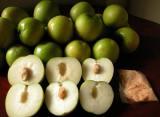 Jujube (Putsa)
Jujube (Putsa)
This is a small, round sweet fruit which can be eaten fresh, processed for fruit
juice or dried.
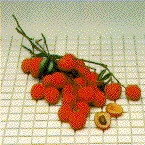 Litchi (Lin-Chi)
Litchi (Lin-Chi)
Another fruit which comes in various forms. Litchi are eaten peeled and seeded,
with the flesh having a sweet taste with a hint of tartness. The skin can vary
from being pinkish in colour to dark red.
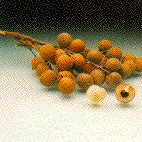 Longan (Lam-Yai)
Longan (Lam-Yai)
A small brown fruit, grown in the North, the crisp skin is removed to reveal a
white flesh with a texture and sweetness similar to a litchi. It is most often
eaten fresh.
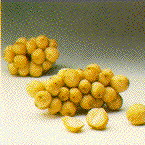 Langsat (Lang-Sat)
Langsat (Lang-Sat)
The skin of young fruit is green, and it turns yellow when it is ripe.
Its thin skin contains milky and sticky sap. The flesh is smokey white and the
seed is green. Be aware not to bite the seed because it is bitter.
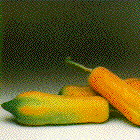 Papaya (Ma-La-Gor)
Papaya (Ma-La-Gor)
A long yellow or orange coloured fruit which is well established in Thai
cooking. It is probably most frequently used in a spicy salad - som tam - where
it is sliced and ground with dried shrimp, garlic and hot chillies. The ripe
fruit is also eaten fresh with a few drops of lime juice.
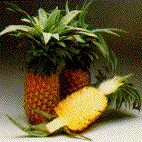 Pinapple (Sapparot)
Pinapple (Sapparot)
The pineapple is grown particularly along the coast of Thailand and the Kingdom
now ranks as one of the world's leading exporters of canned pineapple. It can
either be eaten fresh, or used as an ingredient in cooking such as in a spicy
soup called kaeng khua sapparot.
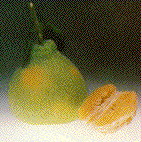 Pomelo (Som-o)
Pomelo (Som-o)
The Thai version of the grapefruit, although slightly larger and with a
sweet taste. There are a number of varieties, each with different colored flesh
ranging from pale yellow and orange to red.
Color : yellowish green; flesh-white
Taste : sweet and scented
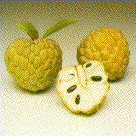 Sugar apple (Noi-Na)
Sugar apple (Noi-Na)
Also known as a custard apple, it is a heart shaped fruit with a lumpy green
skin covering masses of sweet scented white flesh. In most cases the fruit can
be divided into two and the creamy flesh eaten with a spoon. Alternatively it is
used as a base for ice cream.
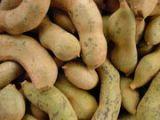 Tamarind
Tamarind
The hard green pulp of a young fruit is very tart and acidic and is
most often used as a component of savory dishes. The ripened fruit is sweeter,
yet still distinctively sour, and can be used in desserts and sweetened drinks,
or as a snack. In Thailand, there is a carefully cultivated sweet variety with
little to no tartness grown specifically to be eaten as a fresh fruit.
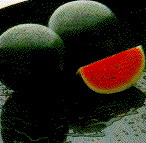 Water melon (Taeng-Mo)
Water melon (Taeng-Mo)
Grown in most areas of Thailand, the watermelon is sweet and refreshing, often
eaten dipped in salt. The juice is often used as a beverage.
รักเธอ ประเทศไทย
Seasons
Regarding seasonality, Thai fruit crops can be classified into two groups. The first is a seasonal fruit crop which includes mangoes, durians, rambutant, longans, sugar apples, mangosteens and lichees. The second group is a year-round crop which includes pineapples, bananas, papayas, and jackfruits. This is the reason why fresh fruit is available in the local market everyday of the year.
Thai resources
- Thai history
- Thai nature
- Thai kitchen
- Thai fruits
- Thai women
- Thai travel
- Thai transport
- Thai-Bulgarian story
Actually, Bangkok is made up of two words, namely ; “Bang”
and “Kok”, signifying a “village” or “district” on the river and a “wild
olive like fruit” respectively. Thus, it means the “village of olives” which
was formerly just a smell fishing villa
ge. Unually Thai people call their capital by its short form “Krung Thep”
which means “City of Angels”.
Facts
Thailand is a paradise for those who love fruit. Generally, Thai fruits are sweet including those which are traditionally sour such as santol and tamarind. Since fruit crops in Thailand are plentiful all the year round, they are becoming more and more important export earners for the country which in 1989 earned up to 8,503.74 million baht from its export of fresh and processed fruits to nearby countries such as Hong Kong, Singapore, and Japan which prefer Thai mangoes especially their favorite type known in Thai as “Nang Klang Wan”.

